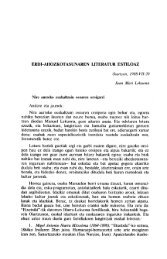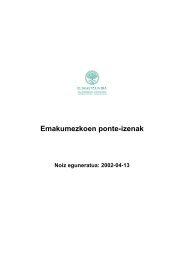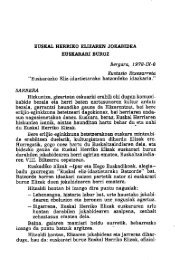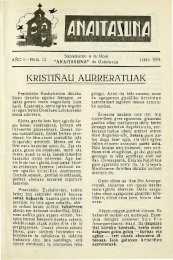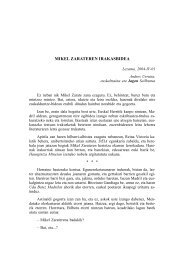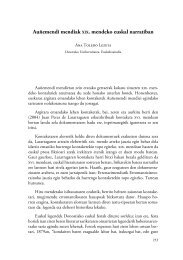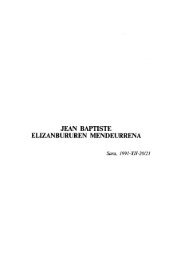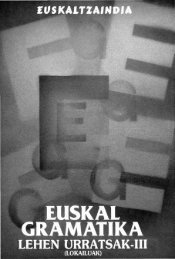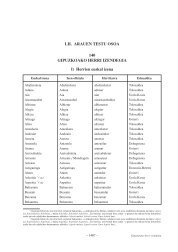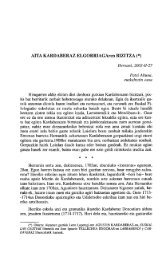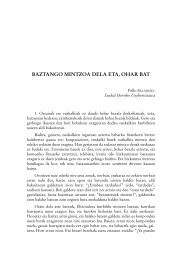Juan Martin Hiribarrenen Eskaraz eguia (1858 ... - Euskaltzaindia
Juan Martin Hiribarrenen Eskaraz eguia (1858 ... - Euskaltzaindia
Juan Martin Hiribarrenen Eskaraz eguia (1858 ... - Euskaltzaindia
Create successful ePaper yourself
Turn your PDF publications into a flip-book with our unique Google optimized e-Paper software.
1192<br />
AltZibAr AretxAbAletA, x.: <strong>Juan</strong> <strong>Martin</strong> <strong>Hiribarrenen</strong> <strong>Eskaraz</strong> <strong>eguia</strong> (<strong>1858</strong>), …<br />
Lan honek J. M. <strong>Hiribarrenen</strong> (1810-1866) prosa eta esaerak azter tzen ditu, kritikariek<br />
gu txi sakonduak baitira. Erakusten du <strong>Eskaraz</strong> <strong>eguia</strong>ren (<strong>1858</strong>) xede apologetiko-didaktikoak<br />
XX. mende erdi tsuko laikotasun, antiklerikalismo eta ateismoaren indar tzeari eran tzun nahi<br />
diola, eta horrek esplika tzen duela eraso eta trufazko tonua, azalpen zorrotz-a tsegingarria,<br />
euskara ulerterrazagoa (Eskaldunac poemakoa baino) eta estilo erretorikoa. Erran eta aforismoei<br />
dagokienez, zehazten du kopurua, motak eta gaiak. Eta adierazten kritikari eta a tsotitz<br />
bil tzaileak zorro tzegi jokatu direla <strong>Hiribarrenen</strong>ak baztertu eta gu txiestean. Eranskinetan<br />
adibide ugari bil tzen dira, esandakoaren erakusgarri.<br />
Hitz gakoak: Euskal literatura, XIX. mendea, prosa, lapurtera, a tsoti tzak, aforismoak.<br />
Este trabajo analiza la prosa y los refranes de J.M. Hiribarren (1810-1866), aspectos poco<br />
investigados por los críticos. Demuestra que el objetivo apologístico-didáctico de <strong>Eskaraz</strong> egia<br />
(<strong>1858</strong>) era responder al auge que el laicismo, del anticlericalismo y el ateísmo a mediados<br />
del siglo. Eso explica el tono burlesco y agresivo, la explicación de la doctrina de una manera<br />
severa pero también amena, un euskera más comprensible (en comparación con el poema<br />
Eskaldunac) y el estilo retórico. En cuanto a los dichos sentenciosos y a los aforismos, especifica<br />
cúantos son, de qué tipo y cuáles son los temas. En conclusión, el autor afirma que los<br />
críticos y los recopiladores de refranes han sido excesivamente severos al marginar y menospreciar<br />
a Hiribarren. En los anexos se muestran multitud de ejemplos de lo dicho.<br />
Palabras clave: Literatura vasca, siglo XIX, prosa, labortano, refranes.<br />
Cet ouvrage analyse la prose et les proverbes de J.M. Hiribarren (1810-1866) qui ont été<br />
très peu étudiés par les critiques. Il démontre que l’objectif apologétique-didactique d’<strong>Eskaraz</strong><br />
Egia (<strong>1858</strong>) était de répondre à l’essor que connurent le laïcisme, l’anti-cléricalisme et<br />
l’athéisme au milieu du XIX e siècle. Ceci explique le ton burlesque et agressif, l’explication de<br />
la doctrine d’une manière rigoureuse mais quand même agréable, un basque plus compréhensible<br />
(en comparaison avec le poème Eskaldunac) et le style rhétorique. En ce qui concerne<br />
les pensées et les aphorismes, il définit la quantité, le type et le thème. En conclusion l’auteur<br />
affirme que les critiques et les compilateurs de proverbes ont été excessivement sévères en<br />
écartant et sous-estiment Hiribarren. On en trouvera de nombreux exemples en annexe.<br />
Mots-clés: Li ttérature basque, XIX e siècle, prose, labourdin, proverbes.<br />
This work examines the prose and sayings of J. M. Hiribarren (1810-1866), because li ttle<br />
a ttention has been paid to them by the critics. It shows that the apologetic-didactic aim of<br />
<strong>Eskaraz</strong> Egia (<strong>1858</strong>) was to respond to the strengthening of middle 19th century laity, anticlericalism<br />
and atheism, and this accounts for its aggressive, mocking tone, its rigorous and<br />
pleasant explanations, its more comprehensible Basque (more than that of the poems in<br />
Eskaldunac) and its rhetorical style. As regards the sayings and aphorisms, it specifies the<br />
number, type and subject ma tter. And it states that critics and compilers of proverbs have<br />
been too categorical when discounting and underestimating those of Hiribarren. Numerous<br />
examples are included in the appendices to support the assertions made.<br />
Key Words: Basque literature, 19 th century, prose, labourdin (Basque dialect), proverbs,<br />
aphorisms.<br />
Euskera. 2010, 55, 3. 1191-1224. Bilbo<br />
issn 0210-1564



